Heard it from a Scout: Five summer camping safety tips
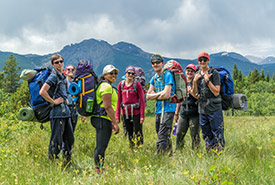
Scouts with their camping gear (Photo by Scouts Canada)
Summer is officially underway, and with it comes prime camping season. Scouting is all about connecting with nature and experiencing the exhilaration and challenge of outdoor adventures, such as hiking, rock climbing, paddle sports and, of course, sleeping beneath the stars.
Whether you are a veteran camper or thinking of planning your first trip, here are five essential summer camping safety tips that Scouts always consider before hitting the trail:
1. Be prepared
Research your destination to ensure that you know:
- The rules and regulations for the campsite and available facilities nearby, including washrooms and fire pits;
- Whether there is a policy regarding pets on-site;
- If swimming is supervised;
- The types of wildlife that live in the area; and
- How accessible day trips are from the campsite.
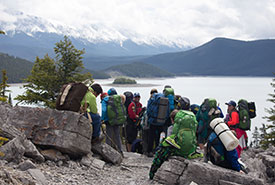
Point campground (Photo by Scouts Canada)
Choose a location that meets your skill level to help ensure a successful camping trip. Additionally, know where the closest gas station, hospital or first response services are located in the event of an emergency, as cellphone service may not be available.
2. Protection from the elements
The weather can make or break an outdoor adventure, if you are not prepared. Before setting out on a camping trip, check the weather forecast and plan accordingly. Even if you’re adventuring close to home, ensuring you have the proper gear can make a huge difference.
For shelter, be sure to have a tent and sleeping bag that’s right for the season. You can also build a simple shelter with a tarp and rope to protect you from the elements.
3. Packing smart
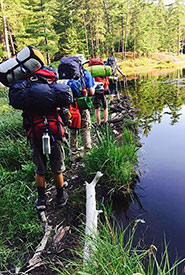
Trail across a beaver dam at Wagon Road, Lake 4th, Trafalgar Ventures (Photo by Scouts Canada)
Making sure you have the appropriate clothing to suit your activity plans and changing weather conditions is essential to your comfort in any situation. Rain gear can make a dreadful day more promising, and having items made from quick-drying fabrics, like polyester or nylon, is helpful.
From experience, I always like to pack clothing that not only dries quickly, but will also keep me comfortable while curled up next to a campfire. Keeping a set of dry clothing for sleeping and emergencies is important because hypothermia can also happen in the summer.
While you may be inclined to slip on a pair of flip-flops while hanging around the campsite, wearing something sturdy or closed-toe is bound to be more comfortable, and less likely to result in an injury. It is always best to take more than you need on your first few trips to get a feel for how you and your body react to the changing elements.
4. Food and hydration
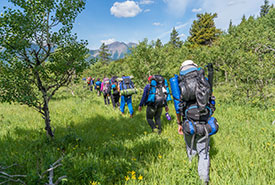
Hiking in single file toward the campsite (Photo by Scouts Canada)
Before embarking on your trip, research whether a drinkable water source is located near your campground. If not, pack clean water for drinking and cooking, or filter your water with a pump or gravity-fed water filter. You can find purification tablets like Aquatabs in many outdoor equipment stores, including the Scout Shop.
Avoid attracting wildlife to your site by using proper food storage. To reduce risk, store your food in the car. Tips like bagging your food and hanging it from a tree branch away from the trunk and your tent will minimize risk. Be sure to pack non-perishable items to avoid spoiled food.
Lastly, practice the Leave No Trace principle at all times, to reduce your impact on the environment. Collect all your garbage produced during the trip and dispose of it responsibly. Leave nothing but footprints behind.
5. Accommodation
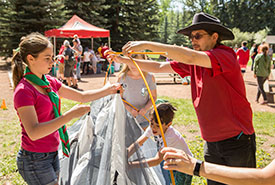
Scouts learning to pitch a tent (Photo by Rene Michaud)
I used to worry about sleeping in a tent, until I tried it. It is a great way to feel closer to nature and wake up with a view that can’t be beat. A perfect tent for summer camping is one with good ventilation and a fly — a tarp that covers the entire tent and door, providing protection from the elements.
Avoid pitching your tent too close to rivers and lakes, in depressions or the bottom of a hill (in case of flooding). Also check for overhead hazards, such as ant and wasp nests, or dead tree limbs that could break off and fall on the tent. Pegging your tent properly will also reduce the risk of the wind blowing it away.
Temperatures at night can drop drastically, so make sure your sleeping bag is warm enough. A temperature rating of 0 C to 15 C is typically suitable for summer. Don’t forget a sleeping pad for maintaining body heat. A sleeping pad creates an insulator between your body and the cool ground, not to mention a little cushioning for a more comfortable sleep.
Maximizing the opportunities that Canada’s national parks offer makes for exciting adventures and memories that can last a lifetime. Always let someone know where you are going and when you expect to return.
Keep these tips in mind to have a safe and fun experience while at a campground, national park or even your own backyard.
"Heard it from a Scout" is written by members of Scouts Canada’s Youth Spokesperson program. This post was authored by Kaitlyn Patterson.

